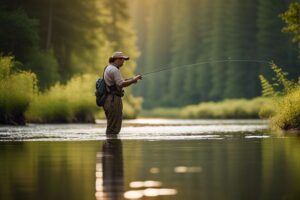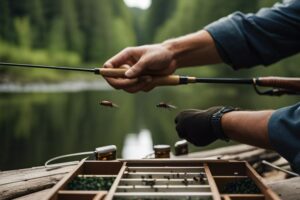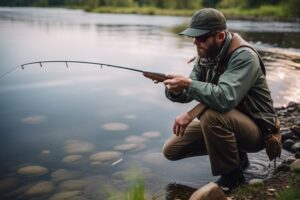Just as the river flows, so too do mayflies drift on the water’s surface, drawing hungry fish to the surface. Knowing which mayfly patterns to use can make the difference between a fruitful day on the water and a string of missed opportunities. In this guide, you’ll discover the top mayfly patterns that replicate these elusive insects, ensuring your fly box is equipped for success. With the right patterns in hand, you’ll increase your chances of landing that prized catch, making your time on the river even more rewarding.
Mayfly Basics
Before you cast your line, it’s important to understand the creatures that are often the stars of the show: mayflies. These aquatic insects are not only fascinating but also crucially important to the ecosystems in which they thrive. Their presence signifies a healthy body of water, and as a fly angler, knowing their life cycle can enhance your fishing success. Mayflies live in the water as nymphs before they emerge into the air as adults, offering unique opportunities for anglers to match the hatch with various fly patterns.
Life Cycle of Mayflies
For a fly fisher, understanding the life cycle of mayflies is key. They undergo an incomplete metamorphosis, transitioning through several nymph stages before emerging as adults. This cycle begins in the spring or early summer when adult females lay eggs on the water’s surface. These eggs hatch into nymphs, which can live for several months or even years, depending on the species and environmental conditions.
As spring turns to summer, the nymphs swim to the surface to emerge, a stage known as “dun.” After shedding their skin and drying their wings, they become “spinner,” the mature form ready to mate. This cycle can happen several times throughout the year, with different species of mayflies emerging at different times, presenting a buffet for hungry trout. For you, recognizing these stages can significantly improve your chances of a successful day on the water.
Importance of Mayflies in Fly Fishing
On any given day by the river, mayflies hold a special place in the hearts of fly fishers. They form a primary food source for many freshwater fish, particularly trout. The hatch can be so prolific that every trout in the area becomes fixated on these delicate insects. This creates an exciting opportunity for you to match your fly patterns to whatever stage of the mayfly life cycle is currently active.
Cycle through your mayfly patterns and observe your surroundings. When you see mayflies hatching, it’s time to select your flies with precision. Whether it’s nymphs, duns, or spinners, matching the right pattern to the existing hatch can mean the difference between a day full of action or casting into silence. Understanding mayflies and their significance can surely elevate your fly fishing adventures.
Dry Mayfly Patterns
One of the most effective ways to entice fish during a mayfly hatch is by using the right dry fly patterns. These delicate imitations float on the water’s surface, creating a realistic representation of the mayflies that trout can’t resist. It’s crucial to match the size and color of your fly to the specific mayflies in your waters. When in doubt, you might want to check out Phil’s Top 6 Patterns for Spring Mayfly Hatches, as these tried-and-true patterns can make all the difference on tough days.
Classic Patterns
On your quest for catching trout during mayfly hatches, classic patterns such as the Adams, the CDC Dun, and the Parachute Adams should be part of your arsenal. These time-honored flies have been used effectively for decades and can mimic different species of mayflies based on their color and silhouette. The Adams, with its distinctive gray and brown hues, offers a versatile option for varying conditions, while the CDC Dun sports natural materials that create a lifelike floating effect.
On the other hand, the Parachute Adams is an exceptional choice for its visibility on the water. With a unique parachute design, this fly presents a profile that not only looks appealing to fish but also enhances your casting precision. Using these classic patterns can be simple yet effective, providing you with a solid foundation for your dry fly fishing endeavors.
Modern Twists
One of the exciting aspects of fly fishing is how patterns evolve. Modern twists on traditional mayfly patterns often incorporate innovative materials and techniques to improve their effectiveness. Flies like the Soft Hackle Mayfly and the Foam Mayfly Dun feature bright colors, lightweight bodies, and buoyant materials, making them rise better and attract more attention from feeding fish. These modern designs don’t just mimic the mayflies; they enhance the visual and tactile experience, causing fish to strike more readily.
Patterns that embrace these new materials appeal to your instinct for experimentation. You can vary the sizes and colors based on observed hatches, allowing you to adapt quickly to fishing conditions. By blending the classics with modern influences, you’ll create a versatile box of flies that can handle any mayfly hatch that comes your way.
Nymph Mayfly Patterns
Keep your tackle box stocked with effective nymph patterns, as they can be the difference between a fish-filled day and coming home empty-handed. Mayfly nymphs, which dwell below the surface, are crucial to a trout’s diet. You will often find them in varying hues, mimicking the natural colors of these aquatic insects. When the mayflies start to hatch, their underwater stages tend to go unnoticed by anglers. But with the right nymphs, you can exploit this feeding frenzy. A good nymph pattern should mimic the silhouette and movement of these creatures to entice hungry trout.
Traditional Favorites
Nymph patterns like the Hare’s Ear and Pheasant Tail have stood the test of time for good reason. These flies feature realistic segmentation and color variations that help you match the natural nymphs in your local waters. The Hare’s Ear, with its shaggy dubbing, creates a lifelike appearance that can fool even the wariest fish. Meanwhile, the Pheasant Tail is a staple due to its simplicity and effectiveness. When you tie them on your line, you can feel confident these classics will entice fish that are feeding below the surface.
New School Options
Pheasant Tail variations and other innovative designs have emerged to meet the needs of modern anglers. Patterns such as the Supernatural Nymph and the Frenchie combine classic techniques with contemporary materials, creating an enticing profile that has proven effective in numerous fishing scenarios. You may notice these flies incorporate flashy elements that catch the attention of fish, even in murky waters. This adaptability is key, as trout often become selective, preferring specific patterns based on the conditions and the hatch.
Another standout is the UV CDC Nymph, which uses ultraviolet materials in its construction that reflect light in unique ways. This not only adds visibility but also provides a natural sheen that imitates the wet, shiny appearance of real nymphs. By experimenting with these new school options, you can keep your fly selection fresh and improve your chances of landing fish throughout diverse fishing environments. Whether you find yourself in fast-flowing streams or placid lakes, don’t shy away from branching out—the evolution of nymph patterns could just be your ticket to success.
Emerger Mayfly Patterns
Unlike traditional dry flies, emerger patterns are designed to replicate mayflies in their transitional phase, as they break through the surface film and begin their ascent. This stage of the life cycle can be crucial for anglers since fish often target these vulnerable insects. When you present an emerger, you’re mimicking the delicate struggle of a mayfly as it escapes from the nymphal shuck, making it an enticing morsel for hungry trout that are keenly aware of this phenomenon.
Surface Film Specialists
Mayfly emerger patterns are especially effective when you’re in the midst of a hatch. Using a fly that sits just at the edge of the surface film gives you an edge; the fish cannot resist the sight of a half-submerged mayfly. Implementing patterns like the Dun Variants or Parachute Emergers allows you to catch fish that are looking up, focusing on these subtle features on the water’s surface. It’s a dance of delicacy, and timing here is everything. You want your presentation to be precise, ghosting along the surface just as the real mayflies are attempting to emerge.
Sub-Surface Options
On some days, trout can exhibit a strong preference for feeding beneath the surface, particularly when conditions are challenging for surface feeding. Using sub-surface emerger patterns, such as the midge or a soft-hackle variant, can lead to a successful outing. These flies allow you to exploit the fish’s natural instinct to hunt for food just below the surface, where many mayflies will linger during their final transition to adulthood.
The key to success with sub-surface options lies in the retrieval method you choose. Employing a slow, erratic retrieve can imitate the fluttering motion of a struggling mayfly, drawing in trout that are lurking below. Additionally, fishing your emergers at varying depths can help target fish that may be a bit picky on a particular day. Know the water you’re in, adapt your approach, and you will find success amidst the mayfly hatch. Each cast is not just a chance; it’s an invitation to the wild heartbeat of the river.
Mayfly Patterns for Specific Species
To successfully target specific species, you’ll need to choose your mayfly patterns wisely. Each fish, whether it be trout, bass, or panfish, reacts differently to various mayfly hatches. Understanding these nuances will improve your chances of a successful outing on the water. This chapter examines into tailored mayfly patterns suited for these popular game fish, ensuring you have the right tools to entice them as they rise in search of that familiar morsel on the surface.
Trout Favorites
Mayfly imitations are a staple for enticing trout. Patterns like the Adams, Parachute Adams, and Blue-Winged Olive are favorites among fly anglers. These flies replicate the natural mayflies that trout feast upon during hatching periods. When you present these flies on a quiet, glassy surface, you increase your odds of encountering a keen-eyed trout. The subtle drag-free drift is crucial; it mimics the real thing, giving you an edge in low-light conditions or during evening hatches.
In fast-moving streams, you might consider using a nymph pattern like the Hare’s Ear or Pheasant Tail. These underwater representations of mayfly larvae appeal directly to trout lurking below the surface, waiting for a meal to drift by. Don’t hesitate to experiment with varying sizes and colors; sometimes, a slight variation can provoke a violent strike from a hesitant fish.
Bass and Panfish Options
Drake-style patterns may not initially come to mind when you think of bass and panfish, but these fish also respond eagerly to mayflies. Largemouth bass, in particular, can be drawn to larger mayfly imitations like the Hexagenia or Marabou Muddlers. Presenting these flies near cover during evening hatches can provoke explosive strikes. Panfish, on the other hand, are attracted to smaller patterns, like the Griffith’s Gnat or Quill Gordon. These delicate imitations can lead to a flurry of bites, especially when Pennsylvania blue-winged olives are drifting at the surface.
Patterns that suit bass and panfish provide versatility in your fly box. Think about fishing them in shallow waters where you can observe feeding behavior. Watch for the telltale rings of fish rising and cast accordingly. Timing and observation are key, and with the right pattern, you’ll find that the majority of your success comes from adapting to what nature is offering that day. The art of mayfly fishing for these species resides in your ability to read the water, and to choose the right moment to present your offering.
Tying Mayfly Patterns
After you’ve settled on the best mayfly patterns for your fishing adventures, it’s time to get your hands dirty and tie some flies. Creating these delicate imitations requires both the right materials and techniques to ensure that your patterns will stand up to the scrutiny of hungry trout. The art of tying mayflies lies not just in imitation but in the subtleties of presentation, where every detail can mean the difference between a successful day on the water or returning home empty-handed.
Essential Materials
To tie effective mayfly patterns, you’ll need a selection of quality materials. Start with various sizes of hooks that match the hatch you’re targeting. Using dry fly hooks or wet fly hooks can really depend on your personal preference and the specific mayfly species in your area. Next, choose feathers or synthetic fibers for the tail and wings, ideally matching the color and texture of local mayflies. You might reach for a mix of dubbing for the body, and don’t forget the thread; a fine thread in colors that complement your body material will help create a seamless look.
In addition, consider adding some weighting material if you’re crafting nymph patterns. For these, split shot or bead heads can provide that necessary sunk effect. Lastly, keep a variety of tools on hand: scissors, a bobbin holder, and a whip finisher will make your tying far more efficient. Quality materials, varied sizes, and the right tools are imperative ingredients for tying mayflies that fish can’t resist.
Pro Tips for Tying Mayflies
Tips for tying mayflies often revolve around the importance of detail and realism. You should focus on proportion; each component of the fly plays a role in its overall effectiveness. Keep the thread tension just right – too tight, and the materials can break or displacement, too loose, and it can unravel. The positioning of your materials is crucial; ensure the wings are upright and the tail is long enough, since this mimics the natural behavior of a mayfly. Additionally, just a touch of puckering in the body can imitate the naivety of a real mayfly’s surface tension, attracting the keenest eyes of predator fish.
- Maintain consistency in your thread wraps to create a neat fly.
- Experiment with different colors to match seasonal hatches.
- Practice your technique until the movements become second nature.
- Recognizing the right time to fish can enhance your success.
Engaging with the fly-tying process can offer a deeper connection to your fishing. Once you master the basics, don’t hesitate to innovate and adapt each pattern to suit your needs. Start with the fundamentals, but as you gain confidence, explore variations that cater to unique fishing conditions and personal preferences.
- Experiment with alternative materials for different textures.
- Observe real mayflies closely to refine your patterns.
- Keep a record of effective patterns and their conditions.
- Recognizing the small differences can lead to bigger catches.
Tying mayfly patterns is not just about mechanics; it’s a craft requiring patience and precision. Strive to weave each element gracefully, as this attention to detail is what ultimately draws the creatures of the stream to your offering. With practice and persistence, you will develop a repertoire of mayfly patterns that not only enhance your angling but also add to the enjoyment of the outdoors.
Conclusion
To wrap up, having a selection of top mayfly patterns in your fly box is important for navigating the waters where these insects thrive. Mayflies represent lifeblood for many fish, and knowing which patterns to use at the right time can be the difference between a successful outing and an empty net. Whether you choose to match the hatch or employ your own interpretation, the key lies in understanding the behavior of the fish and the specific conditions of the water you’re in.
Your experience on the river will be enriched by mastering these mayfly patterns. Keep in mind, fly fishing is as much about patience and observation as it is about technique. When you tie on that perfect mayfly imitation, you not only honor a tradition but also connect with the primal nature of the sport. Trust your instincts, stay attuned to the rhythm of the water, and let your mayfly patterns do the talking for you.
FAQ
Q: What are the most effective mayfly patterns for different seasons?
A: The effectiveness of mayfly patterns can vary by season. In early spring, small BWO (Blue-Winged Olive) patterns work well as mayflies begin to hatch. During the warmer summer months, larger patterns like the Adams or Hendrickson are often more effective, particularly in the evening when mayflies are more active. In fall, Trico and larger October Caddis patterns can be beneficial as fish prepare for winter. Always consider the local insect hatches and water temperature to select the best pattern.
Q: How do I choose the right size mayfly pattern for my fishing location?
A: Choosing the right size mayfly pattern largely depends on the specific insect hatch in your fishing location. Pay attention to the size of mayflies you observe in the water; match your flies closely to their size for the best results. It’s recommended to carry a variety of sizes in your fly box, typically ranging from size 14 to size 22, as fish may become selective based on the prevailing hatch. Consulting local fishing reports can also provide information on the current hatch size.
Q: What materials are best for tying effective mayfly patterns?
A: When tying mayfly patterns, it’s important to use high-quality materials to ensure durability and lifelike presentation. Common materials include dry fly hackle for the wings, synthetic or natural dubbing for the body, and either elk hair or deer hair for the parachute or tail. For nymph patterns, consider using beads for weighting, and soft hackle or rubber legs for added movement. The choice of materials can affect the floatation and appearance of the fly in the water, so experimentation is key to finding what works best for your local waters.


